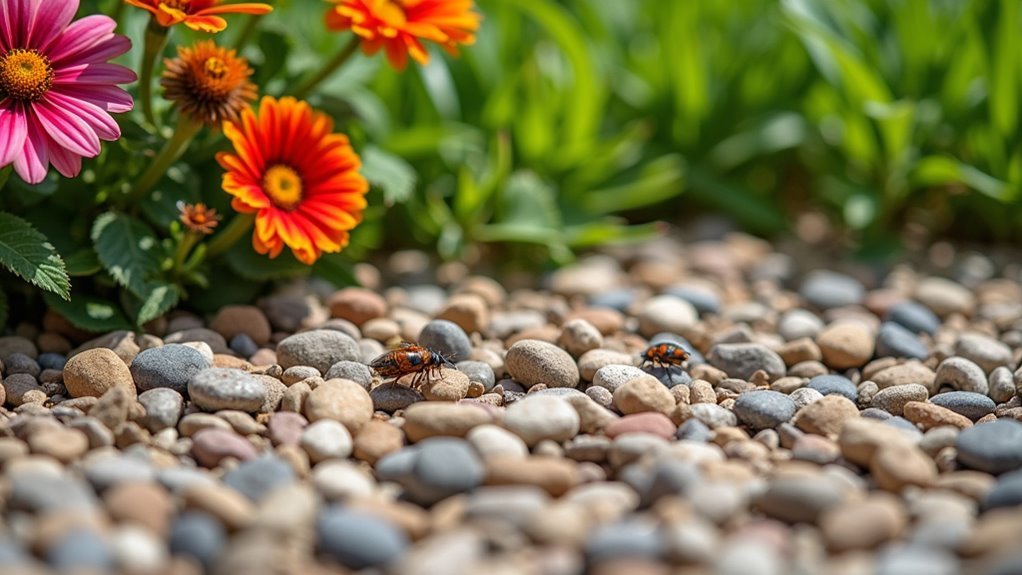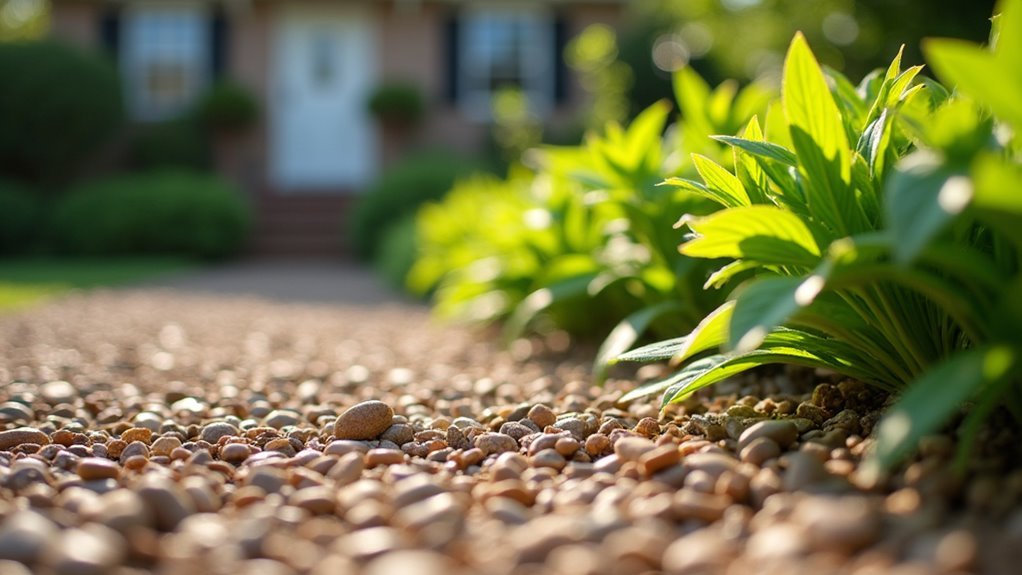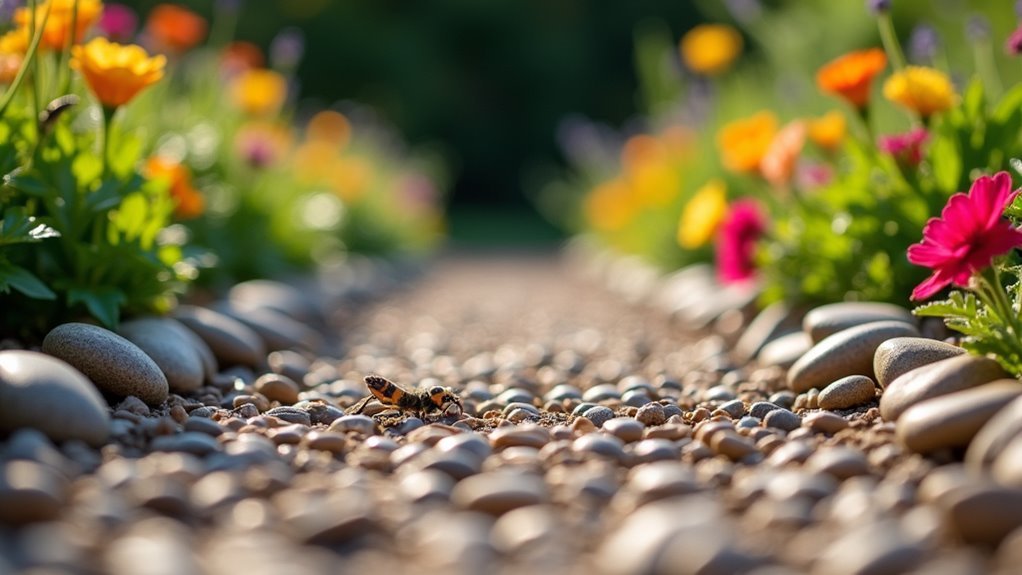You can create effective pest barriers using gravel because it disrupts movement patterns and creates uncomfortable textures that deter rodents and insects from crossing. The unstable surface makes navigation difficult while eliminating moisture retention that attracts pests. Crushed granite’s sharp edges particularly discourage burrowing, while the open texture prevents insects from locating food sources. At $10-$50 per cubic yard, gravel offers cost-effective, chemical-free protection that’ll transform your garden’s defense strategy.
Understanding How Gravel Creates Physical Barriers

When you’re looking for an effective, natural way to protect your garden, gravel creates a formidable physical barrier that disrupts pest movement patterns and makes it difficult for unwanted visitors to reach your plants.
The texture of small roundish stones works against burrowing tendencies, making gravel less attractive to rodents compared to organic materials that they’d typically dig through.
Small roundish gravel stones create an uncomfortable texture that naturally deters rodents who prefer softer, organic materials for burrowing.
Your gravel barrier needs proper dimensions to maximize effectiveness. You’ll want to install it at least half a foot deep to prevent pests from tunneling underneath, while maintaining approximately two feet in width to stop them from jumping over.
These physical barriers create uneven surfaces that redirect insects and rodents away from your protected plants, enhancing your overall pest management strategy.
The Science Behind Why Pests Avoid Gravel Surfaces
Because gravel fundamentally alters the ground environment, pests encounter multiple biological deterrents that work against their natural behaviors and survival instincts.
You’ll find that gravel disrupts pest navigation through its uneven surfaces, making movement difficult and energy-intensive. The barrier effect occurs because insects like ants and cockroaches can’t locate their preferred food sources or establish shelter in gravel areas.
Rodents instinctively avoid these open spaces since they lack protective cover for safe passage. When you replace organic mulch with gravel, you’re eliminating moisture retention that attracts many pests.
The texture specifically challenges burrowing species, as smaller stones like pea gravel complicate digging and nesting attempts, creating an environment that’s biologically unsuitable for pest establishment.
Types of Gravel Most Effective for Pest Deterrence

Understanding how gravel disrupts pest behavior naturally leads to selecting the right type for maximum effectiveness.
Selecting the most effective gravel type requires understanding how different textures and sizes naturally interfere with pest movement patterns.
You’ll find crushed granite gravel works best as a pest deterrent due to its sharp edges, creating uncomfortable surfaces that discourage burrowing rodents from traversing your garden boundaries.
Pea gravel offers excellent versatility for your gravel barrier, with small rounded stones measuring 1/4 to 1/2 inch that remain less hospitable to pests while providing easy walkability for pathways and borders.
River rock, though more decorative, proves less effective because larger sizes create gaps pests can navigate through.
When choosing between types of gravel, guarantee you apply at least 2 inches depth for substantial barrier protection.
You can select different colors and textures to enhance your garden’s aesthetic appeal without compromising effectiveness.
Proper Depth Requirements for Maximum Protection
The depth of your gravel barrier determines whether pests will navigate around, over, or through your protective perimeter. You’ll need at least six inches of depth to create an effective deterrent against burrowing rodents. This substantial physical barrier prevents most pests from digging underneath into softer soil beneath.
| Depth | Width | Effectiveness | Pest Type | Durability |
|---|---|---|---|---|
| 3 inches | 1 foot | Poor | Surface only | Low |
| 6 inches | 2 feet | Excellent | Most rodents | High |
| 8 inches | 2.5 feet | Maximum | All burrowers | Very High |
| 4 inches | 1.5 feet | Fair | Small pests | Medium |
| 12 inches | 3 feet | Overkill | All types | Maximum |
Ensure your gravel’s evenly distributed and compacted to maximize protection while preventing erosion that compromises barrier integrity.
Strategic Placement Around Home Foundations

Foundation placement requires specific measurements and techniques that differ from garden bed protection.
When installing your gravel barrier around home foundations, you’ll need to create a strip that’s at least two feet wide and half a foot deep. This thorough coverage disrupts pest movement patterns and creates challenging terrain for burrowing rodents like rats and mice.
Position the gravel directly against your foundation walls, ensuring complete coverage along the perimeter. Pea gravel works exceptionally well because its small rounded stones fill gaps quickly, preventing rodents from finding entry points.
Pea gravel’s rounded stones create an impenetrable barrier against foundation access, filling every gap that rodents might exploit.
This strategic placement doesn’t just block physical access—it also reduces moisture retention near your foundation, making the area less attractive to moisture-seeking pests while enhancing your property’s appearance.
Creating Gravel Pathways to Interrupt Pest Routes
While foundation barriers create a solid perimeter defense, you’ll amplify your pest control strategy by establishing gravel pathways that cut through your garden’s interior spaces.
These strategic routes disrupt pest movement patterns by creating physical barriers that challenge their access to plants. You’ll want to use smaller stones like pea gravel at approximately 2 inches deep to effectively deter ants and roaches, who hate the rough texture and lack of shelter.
The uneven surfaces redirect pests away since they prefer smooth, unobstructed routes. Unlike organic mulch, this gravel barrier minimizes soil disturbance, preventing new pest habitats.
You’ll enjoy minimal maintenance requirements while enhancing your garden’s aesthetics with this long-lasting pest control solution.
Combining Gravel With Other Natural Barrier Methods
Although gravel barriers provide excellent standalone protection, you’ll achieve maximum pest control by layering them with complementary natural defense methods.
You can create extensive pest deterrence by combining multiple strategies:
- Plant defensive hedgerows using aromatic herbs like lavender or rosemary alongside your gravel barriers to repel insects with natural scents while maintaining physical obstacles.
- Position trap crops near gravel boundaries to lure pests away from your main plants, making the gravel your secondary defense line.
- Add water features next to gravel barriers, creating impassable moats that stop crawling insects completely.
- Install living mulch around gravel areas to suppress weeds and attract beneficial predatory insects that’ll eliminate harmful pests naturally.
This multi-layered approach transforms your garden into an impenetrable fortress against unwanted visitors.
Targeting Specific Pests With Gravel Applications
Since different garden pests respond uniquely to various gravel applications, you’ll need to customize your barrier strategies based on the specific invaders troubling your plants.
| Pest Type | Gravel Size | Application Method |
|---|---|---|
| Rodents | Medium-large stones | Create 3-foot perimeter strips |
| Slugs/Snails | Sharp, angular pieces | 2-inch deep pathways |
| Ants/Roaches | Pea gravel | Continuous coverage areas |
For soft-bodied pests like slugs, you’ll want angular gravel that disrupts their movement across uneven surfaces. Rodents avoid open gravel areas since they can’t burrow effectively, making larger stones ideal. When targeting ants and roaches, focus on eliminating their preferred organic materials by replacing soil pathways with pea gravel. This gravel barrier approach removes food sources and shelter these pests typically find in decomposing matter, forcing them to relocate elsewhere.
Installation Techniques for Different Garden Areas
You’ll need different installation approaches depending on where you’re placing gravel barriers in your garden.
Perimeter strips require deeper excavation and wider coverage than pathway applications, while foundation protection demands specific depth requirements.
Your technique should match the garden area’s pest pressure and the barrier’s intended function.
Perimeter Gravel Strip Placement
When properly installed, perimeter gravel strips form an effective first line of defense against garden pests trying to reach your plants.
This barrier that deters unwanted insects and small animals works by disrupting their natural pest movement patterns around your garden beds and patios.
Follow these essential placement guidelines:
- Create adequate dimensions – Make your perimeter gravel strip at least two feet wide and half a foot deep for maximum effectiveness against burrowing and jumping pests.
- Choose appropriate gravel – Use smaller stones like pea gravel, as the uneven surface creates additional deterrence for traversing pests.
- Avoid mowing areas – Don’t place gravel where you’ll need to mow, as this complicates maintenance.
- Maintain regularly – Replenish shifted or settled stones to guarantee continued protection.
Garden Path Barrier Methods
Beyond establishing protective perimeter strips, you can integrate gravel barriers directly into your garden’s pathway system for enhanced pest control throughout different areas. Use pea gravel for pathways since it’s comfortable underfoot while maintaining effectiveness against rodents. Install your gravel barrier at least six inches deep and two feet wide around garden beds where you’ll place pathways.
| Area Type | Gravel Size | Installation Depth |
|---|---|---|
| Main Walkways | Pea Gravel | 6+ inches |
| Border Paths | Small Stones | 6+ inches |
| Plant Perimeters | Fine Gravel | 4-6 inches |
Avoid placing gravel where you’ll need to mow. Instead, focus on walkways and borders around plants where maintenance won’t interfere with your gravel barrier’s pest-deterring function.
Foundation Protection Techniques
Since your home’s foundation serves as the primary entry point for many garden pests, installing gravel barriers around this perimeter creates your most critical line of defense.
Proper foundation protection requires strategic gravel barrier placement to keep rodents and other unwanted creatures from accessing your home’s base.
Here’s how you’ll establish effective protection:
- Dig trenches at least half a foot deep and two feet wide around your entire foundation perimeter.
- Fill completely with gravel, creating an uneven surface that disrupts pest movement patterns.
- Seal entry points by stuffing gravel into existing holes around pipes, vents, and foundation cracks.
- Maintain regularly by replenishing gravel and checking barrier integrity throughout seasons.
This foundation protection method creates an inhospitable environment that discourages burrowing while preventing pests from jumping over the barrier.
Maintenance Requirements for Long-Term Effectiveness
While gravel barriers offer excellent pest control, they’ll only remain effective if you maintain them properly over time.
Your maintenance requirements include regularly checking for settling or displacement, guaranteeing consistent depth of at least half a foot for ideal pest deterrence.
You’ll need to periodically replenish or replace gravel since natural erosion reduces its effectiveness.
Keep the area clear of organic debris like leaves and plant clippings that attract pests.
Inspect barrier edges to prevent soil encroachment, which creates gaps rodents can exploit.
Combine your gravel barrier maintenance with overall yard care by trimming plant bases and managing other pest attractants.
This thorough approach guarantees your barrier provides long-term protection against unwanted garden invaders.
Cost Analysis Compared to Chemical Treatments
When you’re weighing pest control options, gravel barriers deliver exceptional value compared to chemical treatments. A thorough cost analysis reveals significant long-term savings that make gravel barriers an intelligent investment for your garden.
Here’s how the numbers break down:
- Initial Investment – Gravel costs $10-$50 per cubic yard versus chemical treatments requiring $15-$100 per application.
- Recurring Expenses – You’ll avoid multiple seasonal pesticide purchases since gravel barriers provide permanent protection.
- Water Savings – Reduced irrigation needs lower your utility bills compared to chemical methods requiring activation watering.
- Environmental Costs – You’ll eliminate expenses related to potential ecosystem damage from pesticide runoff.
Gravel barriers offer superior financial benefits through their one-time installation and minimal maintenance requirements.
Environmental Benefits of Chemical-Free Pest Control
Beyond protecting your wallet, gravel barriers transform your garden into an environmentally responsible sanctuary that nurtures beneficial wildlife while eliminating chemical contamination.
You’ll create inhospitable environments for unwanted pests without introducing harmful toxins into soil, groundwater, or surrounding ecosystems. This chemical-free pest control approach protects pollinators, birds, and other beneficial creatures that chemicals typically harm or kill.
Your sustainable landscaping choice conserves precious water resources while supporting biodiversity. Gravel barriers discourage moisture-seeking insects and minimize pest habitats naturally, allowing helpful insects to thrive.
You’ll reduce your environmental footprint considerably by eliminating pesticide runoff that damages local waterways and soil health. This eco-friendly solution creates lasting pest management without compromising ecosystem integrity, proving that effective garden protection doesn’t require environmental sacrifice.
Common Mistakes to Avoid When Installing Gravel Barriers
Although gravel barriers offer excellent pest protection, improper installation can transform this effective solution into a costly disappointment.
Poor gravel barrier installation can turn an otherwise effective pest control method into an expensive failure for homeowners.
Avoiding these critical mistakes will guarantee your gravel barrier effectively deters pests:
- Insufficient depth – You must install the barrier at least six inches deep to prevent pests from digging underneath and accessing your garden.
- Inadequate width – Don’t make your barrier narrower than two feet, or pests will simply jump over it.
- Poor placement – Avoid installing gravel in areas you’ll need to mow regularly, as this disrupts the barrier’s integrity.
- Neglecting maintenance – You can’t ignore debris removal and gap filling around your property, as these oversights create entry points for rodents and insects.
Frequently Asked Questions
Does Gravel Deter Pests?
Yes, gravel deters pests by creating physical barriers that disrupt their movement. You’ll find it reduces moisture retention and eliminates shelter, making your garden less attractive to rodents, insects, ants, and roaches.
What Is the Best Gravel for Pest Control?
You’ll find pea gravel works best for pest control. Use smaller stones at two-inch depth to create effective barriers. Choose inorganic materials over organic options since they’re less attractive to rodents and insects.
Does Gravel Deter Mice?
Yes, gravel deters mice effectively. You’ll create an inhospitable environment since mice can’t burrow through gravel’s uneven texture. It reduces moisture they need for nesting and eliminates hiding spots they prefer.
What Are the Disadvantages of Gravel Soil?
You’ll face compacted soil that restricts root growth, poor water retention requiring frequent watering, rapid drainage causing nutrient leaching, low fertility from lack of organic matter, and potentially unattractive landscapes.
In Summary
You’ll find that gravel barriers offer an effective, eco-friendly solution for pest control that’ll save you money in the long run. By choosing the right type of gravel, maintaining proper depth, and placing it strategically around your home’s foundation, you’re creating a natural defense system that won’t harm beneficial insects or contaminate your soil. With minimal maintenance required, you’ll enjoy lasting protection without recurring chemical costs.





Leave a Reply